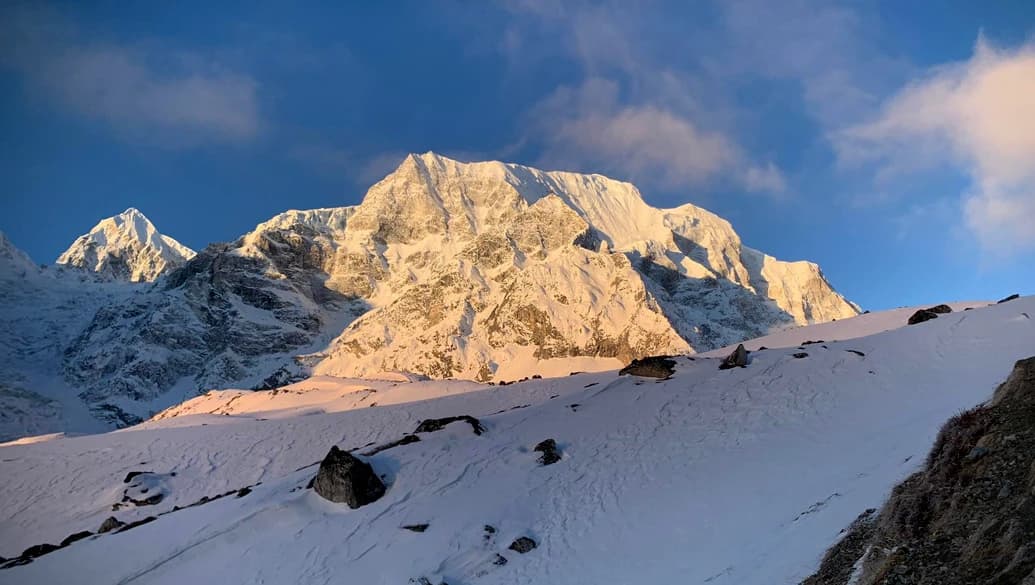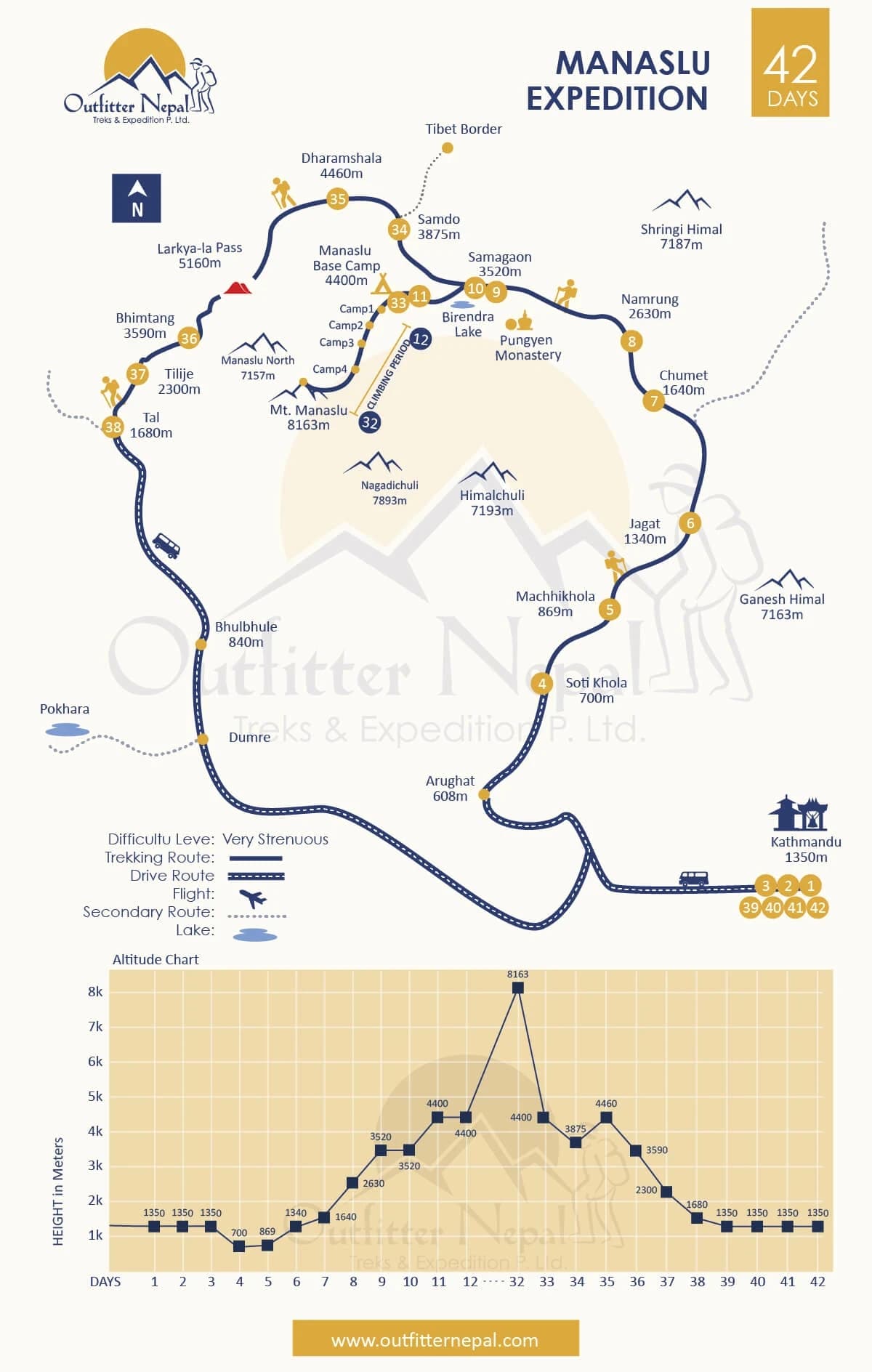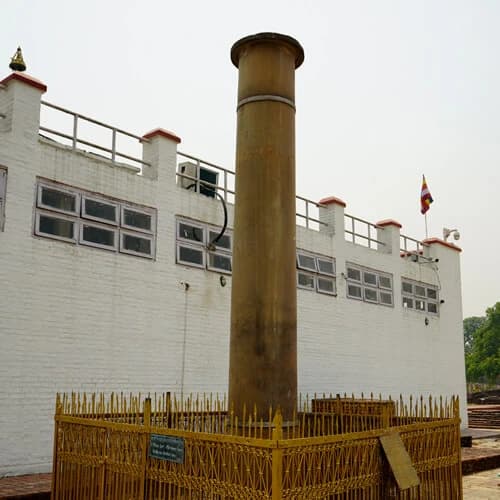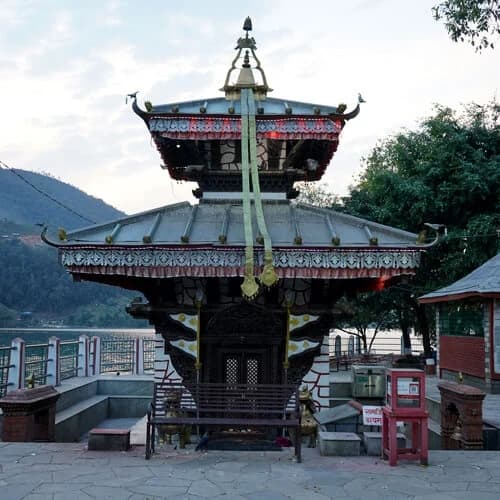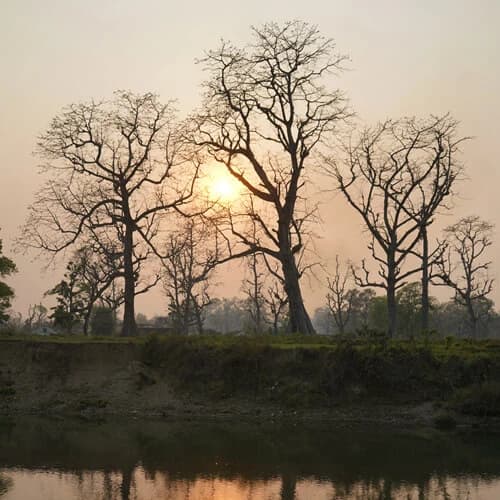Best Features of Manaslu Spring Expedition
- Climbing the eighth-highest mountain peak in the world
- Trekking a difficult trail in the Manaslu region to reach the base camp
- One of the most challenging Himalayan summits for professional mountaineers
- Witnessing a variety of climatic and ecological changes in one excursion
- Experiencing rich cultural exposure in the lower regions of the expedition
- Enjoying the unspoiled natural beauty of the Manaslu region
Mount Manaslu Expedition in Spring Overview
Mt. Manaslu is the eighth-highest mountain in the world, rising 8,163 meters (26,781 feet) above sea level. It is situated in the Mansiri Himal, a modest but impressive sub-range of the Himalayas in northwestern Nepal, some 100 kilometers from Kathmandu in the Gorkha District.
The expedition and trekking routes in the Manaslu region are relatively well-known. Every year, numerous people come to this region to trek along the untamed trails and scale Mount Manaslu. The Manaslu Circuit Trek is one of the well-liked trekking itineraries in this region.
Mt. Manaslu is a difficult summit that calls for experienced climbers who have scaled mountain summits higher than 7000 meters before. It is one of the most difficult climbs among the 14 eight-thousanders. If you ascend Mt. Manaslu, you will have more climbing expertise for the subsequent 8-thousander climbs. There is a quote attributed to Ralph Waldo Emerson that reads, "It's not the destination; it's the journey." This is true for the Manaslu expedition because, without the fight to get there, you might not understand the rush of adrenaline and thrill you experience once you get there.
There are numerous intriguing routes that the Manaslu expedition can undergo to ascend to the summit from Manaslu Base Camp (4,700m). The most common one is the conventional route, the same one taken by the initial 1956 Japanese expedition up the Northeast face. Mt Manaslu isn't the most technical summit to climb, but it requires more technical skill than Shishapangma or Cho Oyu. The Base Camp's low elevation raises avalanche risk.
The Manaslu Expedition in Spring begins with a bus ride from kathmandu to Soti Khola and trekking to Sama Gaun along the Budi Gandaki Valley before ascending the northeast ridge. Before reaching the peak, you must navigate several snowy slopes and an arête. A thin ridge or saddle is a good way to characterize an arête. Following this, there is a difficult ascent to the summit, from which you will unquestionably have some of the most breathtaking views of the Himalayas you can imagine.
Join Outfitter Nepal's Spring Expedition to Manaslu for the story of a lifetime! Reservations are now being accepted for our Manaslu Spring Expedition in 2024 and 2025. As part of our Spring Expedition, our skilled mountaineering Sherpas will guide you to the summit of the formidable Mount Manaslu from the Nepal side. The spring itinerary is carefully planned, with your safety as our priority, taking into account all security considerations.
A Brief History of the Manaslu Expedition
In 1950, HW Tillman and Jimmy Roberts photographed Manaslu during a trek, but a formal survey of the peak only happened in 1952 by a group of Japanese reconnaissance parties who visited Nepal. A group of 15 Japanese climbers led by Y. Mita attempted to ascend the mountain through the east side the next year (1953). They established the base camp at Samagaon but were unsuccessful in climbing the summit. 3 climbers made it to a height of 7,750 meters (25,430 feet) in this first attempt to reach the summit via the northeast face before deciding to turn around.
A furious group of locals met a Japanese expedition at Samagaon camp in 1954 as they approached the mountain through the Budi Gandaki route again. The locals believed that earlier explorations had angered the gods, which resulted in the avalanches that devastated the Pung-Nguyen Monastery and claimed the lives of 18 locals. The crew hastily retreated to Ganesh Himal instead. A sizable payment was offered to repair the monastery to assuage local resentment. The attitude of mistrust toward Japanese expeditions was not lessened by this charitable deed, though.
Despite the odds, on May 9, 1956, Toshio Imanishi (of Japan) and Gyalzen Norbu (of the Sherpa nation) achieved the first ascent of Manaslu. Yuko Maki, also known as Aritsune Maki, served as the team's leader. The challenge of the angered villagers was encountered even in the 1956 expedition. As a result, the next Japanese expedition could not take place until 1971, when another team succeeded in climbing the summit. A South Korean Expedition followed the victory in the same year.
In April 1972, an avalanche killed 5 climbers and 10 Sherpas the moment they made the 4th successful ascent of Mt. Manaslu by climbing from Marshyandi Valley. The first American ascent was achieved by Charlie Mace in 1997. Manaslu is said to have always been a Japanese peak, much like how the British regard Everest as their mountain.
How safe is Mount Manaslu Expedition in Spring?
Up until around five years ago, the history of Manaslu was primarily made up of earnest, modest private excursions. It was a sought-after objective for ardent climbers aiming for a challenging Himalayan summit because it is one of the 14 8,000-meter peaks in the globe. By Himalayan standards, the mountain is not very high and is located off one of the busier trekking paths. However, short does not equate to safe, as history would suggest.
The peak is the fifth most climbed eight-thousander in terms of the number of summits and may be readily ascended under the right circumstances. However, it has a death rate of more than 35% relative to summits. You have no idea what Manaslu will throw at you unless you actually encounter the top or thoroughly investigate it. It has previously been an avalanche chute.
What are the Challenges during the Manaslu Spring Expedition?
Your fitness and alertness will be put to the test at the summit. Although breathing will be difficult, you should be able to adapt to the altitude with sufficient pre-trip acclimatization, enough hydration, and an adequate diet.
The actual alpine challenge starts after we leave the base camp and involves largely climbing on steep ice and snow surfaces. The climbers stage up and set up at base camp, where they will spend the coming days preparing to ascend Manaslu. Manaslu features some of the steepest and longest climbs once you leave camp to camp. There are high risks of avalanches and crevasses opening along the climbing path as it is in an extremely exposed location. The icy slopes under a thick layer of snow make the route tricky and prone to avalanches.
How to prepare for the Manaslu Expedition in Spring?
The expedition of Manaslu is by no means simple. Thus, we ask those who are interested in the challenge to have completed at least one previous high-altitude climb anywhere in the world at the height of 7000+ meters. It is quite difficult to create a simulation using ladders to traverse crevasses in the mountains for real during training. Strength, core, and endurance training should be your main priorities. Any sort of cardiovascular exercises, such as long-distance running (10-20km) three to four times a week, cycling for an hour to two hours, and trekking uphill with 15-20kg weights, are some of the recommended training methods. We also recommend endurance training exercises for preparation. We recommend starting the preparation at least 5 or 6 months before your expedition departure.
Why go on the Manaslu Spring Expedition with Outfitter Nepal?
Any expedition's success depends on having a well-planned itinerary and the best logistics, both of which we offer. We are committed to maintaining the mission's safety and effectiveness with our top-notch service.
We always lay a strong focus on keeping the group small to make it simple for everyone to coordinate and work together. You will be led by mountain guides who are among the best in their field and have made multiple ascents of Manaslu. They have extensive training and expertise. Our mountaineering method is consistent with the decades of summit achievement that our guides, Sherpa, and support staff have to offer.
What is the Cost of the Manaslu Expedition in Spring?
The cost of the Manaslu Expedition depends on various factors. Different trekking and mountaineering agencies set the price based on the services they provide. Local companies provide a better deal than international companies as there's no middleman commission involved when booking with a locally based company. The price also depends on the group size. You're likely to get group discounts if you're in a larger group. After a detailed analysis, we've decided on the prices of our expeditions, which are both affordable for you and profitable for us. At Outfitter Nepal, the cost for the Manaslu Expedition in Spring starts from US$13500.
Manaslu Expedition Route in Spring
There are a number of ways to ascend to the summit from Manaslu Base Camp (4,700m), but the majority attempt it via trekking into Samagaun along the Budi Gandaki Valley before ascending the northeast ridge. Before reaching the peak, you must navigate several snowy slopes and an arête. A thin ridge or saddle is a good way to characterize an arête. Following this, there is a difficult ascent to the summit, from which you will unquestionably have some of the most breathtaking views of the Himalayas you can imagine.
Manaslu Acclimatization Camps
Our Manaslu Expedition follows the Northeast face route, which is the safest and most common route to the summit. This route consists of 4 different campsites, namely Camp 1, Camp 2, Camp 3, and Camp 4, between the Base Camp and the summit.
Base Camp (4800 m)
Manaslu Base Camp is situated on a rocky moraine with breathtaking Himalayan vistas. The climbers will spend most of the time in the base camp training and preparing for the climb. This is going to be your home for about 20 days. You'll have a personal tent, a dining tent, a shower tent, a toilet tent, and a common area. The mountain Sherpa will provide basic mountaineering training and educate you about the route and techniques involved during the summit climb.
Camp 1 (5600 m)
Camp 1 is the first stop you take once you depart from the base camp towards the Manaslu summit. The camp is situated at an altitude of about 5500 meters and is divided into 2 sections: Lower Camp 1 and Upper Base 1, separated by a distance of 100 m. To reach Camp 1, climbers must travel a difficult uphill terrain that passes across moraines and crevassed glaciers.
Camp 2 (6300 m)
Above Camp 1, Camp 2 lies at a height of 6300 m. The route from Camp 1 to camp features crevasses and icefalls with moderately angled snow slopes in the lower parts and a brief steep slope. The climbers must climb 100 meters of vertical walls that are angled at 50 to 60 degrees. It is the most technical section in the entire climb, but once you make it to Camp 2, you'll witness yet another stunning Himalayan peak view. From here, it feels like the mountains are next to you.
Camp 3 (6800 m)
Camp 3 takes you further close to your goal with a short 4 to 5 hours climb on snowy slopes from Camp 2. The climb between Camp 2 to Camp 3 is regarded as the shortest and simplest ascend without any ladder crossings. But one must be careful while jumping off the crevasses that are half meters long.
Camp 4 (7300 m)
Camp 4 is the last campsite before the summit and lies at 7300 meters, approximately 800 meters below the summit. To get to Camp 4, one must climb a steep 55 to 60 degrees slope made with a layer of ice that's entirely covered by snow. The view from here is just mindblowing. From Camp 4, the climbers make it directly to the summit and descend back to the lower camps.

